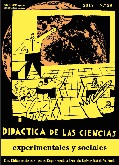Prehistory, disability and care. The importance of inclusive discourses in the teaching and learning of prehistory
DOI:
https://doi.org/10.7203/dces.47.29449Keywords:
prehistory, disability, learning /teaching, secondary, care Abstract
Abstract
The inclusion of people with different identities and conditions becomes a necessity in the teaching and learning of history. In the specific case of prehistory, archaeological research is shedding light on those groups and jobs traditionally made invisible in historical discourse. However, this does not always translate into the construction of inclusive stories.
The work presented here analyses the texts and illustrations of 15 teaching units on prehistory assigned to the LOE, LOMCE and LOMLOE, to determine the presence or absence of care work and references to people with disabilities in human groups in prehistory. The analysis has been carried out following a mixed, quantitative and qualitative methodology. The data collection process has been carried out using a categorical matrix, with a series of a priori categories designed from a bibliographic review and following the main objectives of the study. The results show a scarce and uneven treatment, although with a tendency towards a change in the historical discourse in the manuals assigned to LOMLOE.
 Downloads
Downloads
Downloads
Published
How to Cite
-
Abstract13
-
PDF (Español)24
Issue
Section
License
![]()
The articles published at Didáctica de las Ciencias Experimentales y Sociales will have a Creative Common Licence Creative Commons Attribution-Noncommercial-No Derivative Works 3.0 Unported



